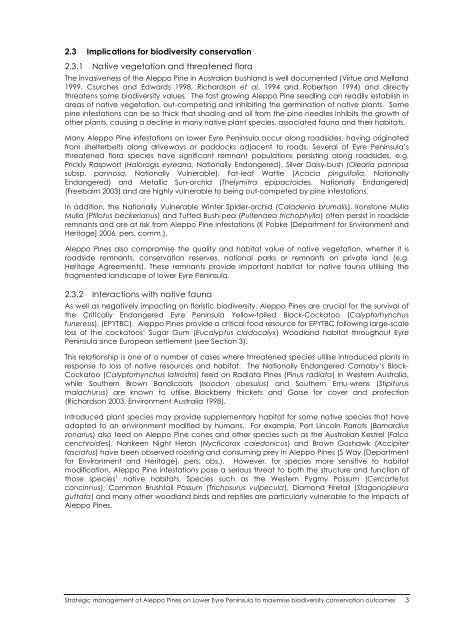Strategic management of Aleppo Pines on Lower Eyre
Strategic management of Aleppo Pines on Lower Eyre
Strategic management of Aleppo Pines on Lower Eyre
Create successful ePaper yourself
Turn your PDF publications into a flip-book with our unique Google optimized e-Paper software.
2.3 Implicati<strong>on</strong>s for biodiversity c<strong>on</strong>servati<strong>on</strong><br />
2.3.1 Native vegetati<strong>on</strong> and threatened flora<br />
The invasiveness <str<strong>on</strong>g>of</str<strong>on</strong>g> the <str<strong>on</strong>g>Aleppo</str<strong>on</strong>g> Pine in Australian bushland is well documented (Virtue and Melland<br />
1999, Csurches and Edwards 1998, Richards<strong>on</strong> et al. 1994 and Roberts<strong>on</strong> 1994) and directly<br />
threatens some biodiversity values. The fast growing <str<strong>on</strong>g>Aleppo</str<strong>on</strong>g> Pine seedling can readily establish in<br />
areas <str<strong>on</strong>g>of</str<strong>on</strong>g> native vegetati<strong>on</strong>, out-competing and inhibiting the germinati<strong>on</strong> <str<strong>on</strong>g>of</str<strong>on</strong>g> native plants. Some<br />
pine infestati<strong>on</strong>s can be so thick that shading and oil from the pine needles inhibits the growth <str<strong>on</strong>g>of</str<strong>on</strong>g><br />
other plants, causing a decline in many native plant species, associated fauna and their habitats.<br />
Many <str<strong>on</strong>g>Aleppo</str<strong>on</strong>g> Pine infestati<strong>on</strong>s <strong>on</strong> lower <strong>Eyre</strong> Peninsula occur al<strong>on</strong>g roadsides, having originated<br />
from shelterbelts al<strong>on</strong>g driveways or paddocks adjacent to roads. Several <str<strong>on</strong>g>of</str<strong>on</strong>g> <strong>Eyre</strong> Peninsula’s<br />
threatened flora species have significant remnant populati<strong>on</strong>s persisting al<strong>on</strong>g roadsides, e.g.<br />
Prickly Raspwort (Haloragis eyreana, Nati<strong>on</strong>ally Endangered), Silver Daisy-bush (Olearia pannosa<br />
subsp. pannosa, Nati<strong>on</strong>ally Vulnerable), Fat-leaf Wattle (Acacia pinguifolia, Nati<strong>on</strong>ally<br />
Endangered) and Metallic Sun-orchid (Thelymitra epipactoides, Nati<strong>on</strong>ally Endangered)<br />
(Freebairn 2003) and are highly vulnerable to being out-competed by pine infestati<strong>on</strong>s.<br />
In additi<strong>on</strong>, the Nati<strong>on</strong>ally Vulnerable Winter Spider-orchid (Caladenia brumalis), Ir<strong>on</strong>st<strong>on</strong>e Mulla<br />
Mulla (Ptilotus beckerianus) and Tufted Bush-pea (Pultenaea trichophylla) <str<strong>on</strong>g>of</str<strong>on</strong>g>ten persist in roadside<br />
remnants and are at risk from <str<strong>on</strong>g>Aleppo</str<strong>on</strong>g> Pine infestati<strong>on</strong>s (K Pobke [Department for Envir<strong>on</strong>ment and<br />
Heritage] 2006, pers. comm.).<br />
<str<strong>on</strong>g>Aleppo</str<strong>on</strong>g> <str<strong>on</strong>g>Pines</str<strong>on</strong>g> also compromise the quality and habitat value <str<strong>on</strong>g>of</str<strong>on</strong>g> native vegetati<strong>on</strong>, whether it is<br />
roadside remnants, c<strong>on</strong>servati<strong>on</strong> reserves, nati<strong>on</strong>al parks or remnants <strong>on</strong> private land (e.g.<br />
Heritage Agreements). These remnants provide important habitat for native fauna utilising the<br />
fragmented landscape <str<strong>on</strong>g>of</str<strong>on</strong>g> lower <strong>Eyre</strong> Peninsula.<br />
2.3.2 Interacti<strong>on</strong>s with native fauna<br />
As well as negatively impacting <strong>on</strong> floristic biodiversity, <str<strong>on</strong>g>Aleppo</str<strong>on</strong>g> <str<strong>on</strong>g>Pines</str<strong>on</strong>g> are crucial for the survival <str<strong>on</strong>g>of</str<strong>on</strong>g><br />
the Critically Endangered <strong>Eyre</strong> Peninsula Yellow-tailed Black-Cockatoo (Calyptorhynchus<br />
funereus), (EPYTBC). <str<strong>on</strong>g>Aleppo</str<strong>on</strong>g> <str<strong>on</strong>g>Pines</str<strong>on</strong>g> provide a critical food resource for EPYTBC following large-scale<br />
loss <str<strong>on</strong>g>of</str<strong>on</strong>g> the cockatoos’ Sugar Gum (Eucalyptus cladocalyx) Woodland habitat throughout <strong>Eyre</strong><br />
Peninsula since European settlement (see Secti<strong>on</strong> 3).<br />
This relati<strong>on</strong>ship is <strong>on</strong>e <str<strong>on</strong>g>of</str<strong>on</strong>g> a number <str<strong>on</strong>g>of</str<strong>on</strong>g> cases where threatened species utilise introduced plants in<br />
resp<strong>on</strong>se to loss <str<strong>on</strong>g>of</str<strong>on</strong>g> native resources and habitat. The Nati<strong>on</strong>ally Endangered Carnaby’s Black-<br />
Cockatoo (Calyptorhynchus latirostris) feed <strong>on</strong> Radiata <str<strong>on</strong>g>Pines</str<strong>on</strong>g> (Pinus radiata) in Western Australia,<br />
while Southern Brown Bandicoots (Isood<strong>on</strong> obesulus) and Southern Emu-wrens (Stipiturus<br />
malachurus) are known to utilise Blackberry thickets and Gorse for cover and protecti<strong>on</strong><br />
(Richards<strong>on</strong> 2003, Envir<strong>on</strong>ment Australia 1998).<br />
Introduced plant species may provide supplementary habitat for some native species that have<br />
adapted to an envir<strong>on</strong>ment modified by humans. For example, Port Lincoln Parrots (Barnardius<br />
z<strong>on</strong>arius) also feed <strong>on</strong> <str<strong>on</strong>g>Aleppo</str<strong>on</strong>g> Pine c<strong>on</strong>es and other species such as the Australian Kestrel (Falco<br />
cenchroides), Nankeen Night Her<strong>on</strong> (Nycticorax caled<strong>on</strong>icus) and Brown Goshawk (Accipiter<br />
fasciatus) have been observed roosting and c<strong>on</strong>suming prey in <str<strong>on</strong>g>Aleppo</str<strong>on</strong>g> <str<strong>on</strong>g>Pines</str<strong>on</strong>g> (S Way [Department<br />
for Envir<strong>on</strong>ment and Heritage], pers. obs.). However, for species more sensitive to habitat<br />
modificati<strong>on</strong>, <str<strong>on</strong>g>Aleppo</str<strong>on</strong>g> Pine infestati<strong>on</strong>s pose a serious threat to both the structure and functi<strong>on</strong> <str<strong>on</strong>g>of</str<strong>on</strong>g><br />
those species’ native habitats. Species such as the Western Pygmy Possum (Cercartetus<br />
c<strong>on</strong>cinnus), Comm<strong>on</strong> Brushtail Possum (Trichosurus vulpecula), Diam<strong>on</strong>d Firetail (Stag<strong>on</strong>opleura<br />
guttata) and many other woodland birds and reptiles are particularly vulnerable to the impacts <str<strong>on</strong>g>of</str<strong>on</strong>g><br />
<str<strong>on</strong>g>Aleppo</str<strong>on</strong>g> <str<strong>on</strong>g>Pines</str<strong>on</strong>g>.<br />
<str<strong>on</strong>g>Strategic</str<strong>on</strong>g> <str<strong>on</strong>g>management</str<strong>on</strong>g> <str<strong>on</strong>g>of</str<strong>on</strong>g> <str<strong>on</strong>g>Aleppo</str<strong>on</strong>g> <str<strong>on</strong>g>Pines</str<strong>on</strong>g> <strong>on</strong> <strong>Lower</strong> <strong>Eyre</strong> Peninsula to maximise biodiversity c<strong>on</strong>servati<strong>on</strong> outcomes 3

















